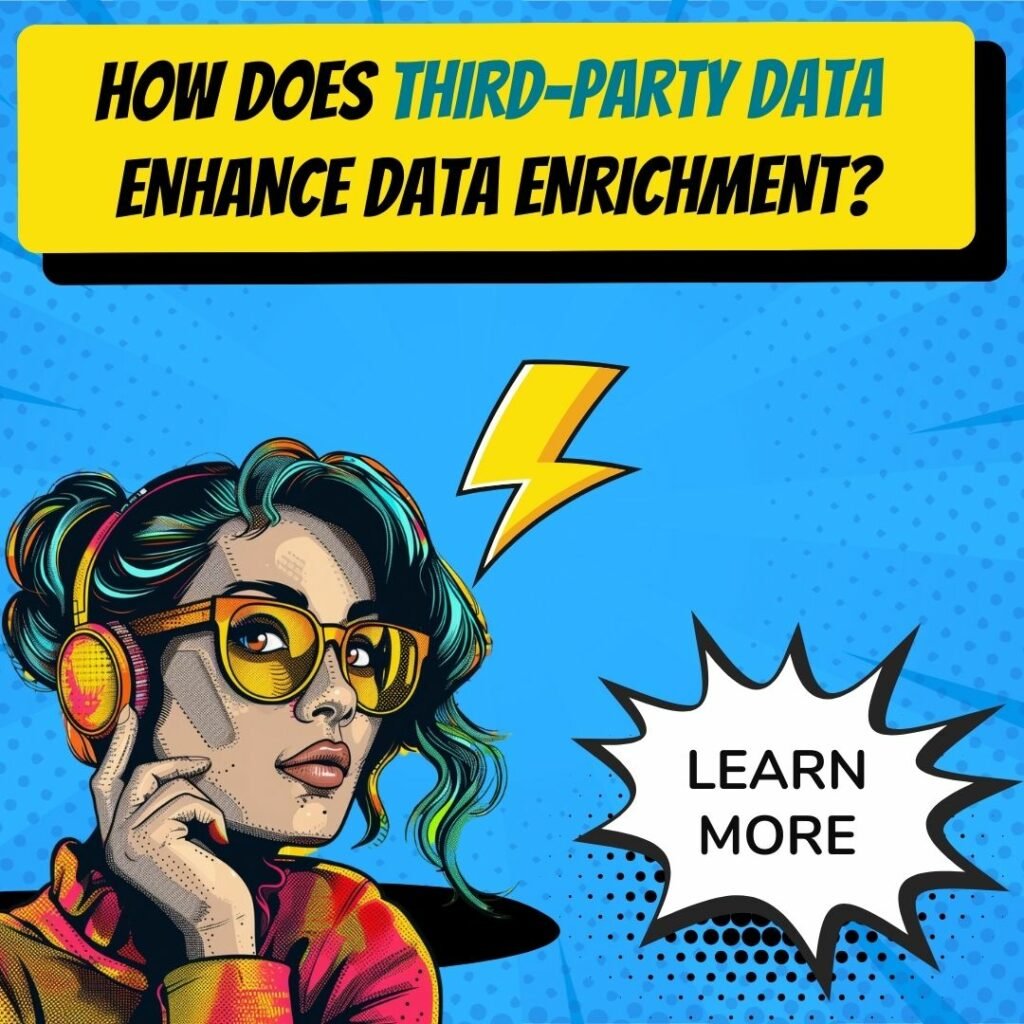Key Takeaways
✅ Improved Targeting and Personalization: Leveraging third-party data and audience insights enhances your understanding of customer behaviors, boosting campaign precision and engagement. Statistics show that businesses using advanced data enrichment strategies see up to a 30% rise in customer satisfaction.
✅ Enhanced Data Quality and Completeness: Combining third-party data with your existing records not only fills critical gaps but also enriches the integrity of your entire dataset. Research indicates a 25% improvement in data accuracy companies experience when integrating external data sources.
✅ Better Insights and Decision-Making: With richer data at your fingertips, your ability to navigate the market and anticipate trends sharpens, potentially increasing ROI by 15-20%. This strategic advantage is key in outpacing competitors.

Introduction
How can third-party data and audience insights significantly boost your data enrichment efforts? With businesses drowning in a sea of data, identifying strategic gems is more crucial than ever. This article delves into the transformative role that third-party data and audience insights play in refining your data processes and crafting sharper market strategies.
We are teetering on the brink of a new era where data is not just abundant but intelligently curated to drive strategic decisions. In this exploration, we uncover modern trends and solutions, aimed particularly at maximizing revenue and ROI through innovative data integration techniques.
Arming you with more than just information, this article promises actionable insights and groundbreaking data tactics that could very well redefine your business landscape. Prepare to dive into a world of enhanced data enrichment that propels business growth and operational efficiency.
Top Statistics
| Statistic | Insight |
|---|---|
| Market Size and Growth: The global data enrichment market size was valued at $1.2 billion in 2020 and is expected to grow at a CAGR of 15.5% from 2021 to 2028. (Source: Grand View Research) | This robust growth indicates a booming market and the increasing importance of data enrichment services for businesses. |
| Third-Party Data Usage: 83% of data and analytics leaders report using third-party data to enhance their analytics capabilities. (Source: Forrester) | Shows the widespread reliance on third-party data to power decision-making and improve analytics. |
| Audience Insights: 74% of marketers believe that audience insights are critical to their business. (Source: Salesforce) | A strong majority indicating that understanding the audience deeply impacts marketing strategies and business outcomes. |
| Industry Forecasts: The healthcare industry is expected to experience the highest CAGR in data enrichment services from 2021 to 2028. (Source: Grand View Research) | Highlights the significant potential and growth in adopting data enrichment services in healthcare for improved patient insights. |
| Data Privacy: 86% of consumers are concerned about data privacy and how companies use their data. (Source: Pew Research Center) | Underlines the critical importance of handling data responsibly and transparently in any data-driven initiative. |
Understanding Third-Party Data
Third-party data encompasses a variety of information gathered from external sources that businesses use to enhance their understanding of customers. This data includes demographic profiles, consumer behavior, transactional histories, and social media activities. Companies often source third-party data from public records, digital footprints on social media, market research firms, and specialized data aggregators. The advantages of using this data are vast, providing deep insights into consumer habits and trends which might not be visible through first-party data alone. However, challenges like data relevance, privacy concerns, and the potential for inaccuracy do exist, making the effective use of third-party data a balancing act between benefit and risk.
Leveraging Audience Insights
Audience insights delve into understanding consumers' behaviors, preferences, and needs by analyzing the data collected from their interactions with digital platforms. These insights are crucial for businesses aiming to tailor their marketing strategies specifically to meet the desires of different customer segments. By effectively analyzing these insights, companies can significantly improve the personalization of their marketing efforts, leading to higher engagement and customer satisfaction. Practical applications include customizing content for specific audiences and more accurately targeting advertising, which can dramatically boost the relevance and effectiveness of marketing campaigns.
Integrating Third-Party Data and Audience Insights
The real magic happens when businesses effectively integrate third-party data with audience insights. Combining these datasets provides a more comprehensive view of the customer, which can enhance every aspect of marketing and sales strategies. Best practices for integration include ensuring data accuracy by validating third-party data sources and seamlessly merging them with first-party data. It's also critical to maintain a high standard of data quality and apply advanced analytics to uncover actionable insights. Through careful integration, companies can achieve a deeper understanding of their customers, leading to improved customer segmentation and more strategic decision-making.
Enhancing Data Enrichment
Enhanced data enrichment leads to clearer customer profiles, which are invaluable in crafting personalized marketing campaigns and improving customer engagement. By utilizing a mix of third-party data and detailed audience insights, companies can create detailed customer segments. This refined segmentation helps in customizing marketing messages that resonate more effectively with each segment, improving the overall performance of marketing campaigns. Moreover, enriched data supports better strategic planning and decision-making, providing a competitive edge in today's fast-paced market environments.
Managing Privacy and Security Concerns
With the increasing use of third-party data, managing privacy and security becomes crucial. Compliance with data protection regulations such as the General Data Protection Regulation (GDPR) and the California Consumer Privacy Act (CCPA) is mandatory. These regulations mandate businesses to handle data transparently and securely to protect consumer privacy. Effective strategies include implementing robust security measures to prevent data breaches and developing clear data policies that respect both legal standards and consumer expectations. By prioritizing data security and ethical data practices, companies not only comply with laws but also build trust with their customers.
By taking a thoughtful approach to integrating third-party data and audience insights, businesses can enrich their understandings in ways that respect consumer privacy while also maximizing the strategic value of the information they gather.
AI Marketing Engineers Recommendation
Recommendation 1: Integrate Third-Party Data for Comprehensive Customer Profiles: To enhance data enrichment, incorporating data from third-party sources can provide a more holistic view of your target audiences. By aggregating information from social media, consumer behavior databases, and demographic data providers, marketers can develop a more nuanced understanding of their customers' preferences, behaviors, and needs. For instance, combining these insights with first-party data can lead to a 360-degree customer view, enabling personalized marketing at scale. A 2021 report from Forrester noted that marketers who use integrated customer data see up to a 6.5 times increase in campaign effectiveness.
Recommendation 2: Utilize Predictive Analytics to Anticipate Customer Needs: Employing predictive analytics tools to analyze both first-party and third-party data can significantly improve the accuracy of your customer predictions. By identifying patterns and trends within the combined data sets, businesses can forecast future behaviors and preferences, allowing for proactive rather than reactive strategies. This approach not only enhances customer experience but also optimizes marketing resources by targeting users more likely to convert. According to a recent study, businesses employing predictive analytics have seen an improvement in their ROI by as much as 20%.
Recommendation 3: Leverage AI-Driven Tools to Process and Utilize Audience Insights: Using AI-driven platforms such as Adobe Experience Platform or Salesforce CDP can streamline the integration and analysis of third-party data. These tools facilitate the seamless incorporation of diverse data sets, applying machine learning algorithms to extract meaningful insights efficiently. The benefit here is twofold: enhanced capability to personalize marketing efforts and improved operational efficiency. Businesses leveraging such technologies report up to a 15% increase in marketing efficiency, according to IBM's marketing analytics insights.
Relevant Links
- Affiliate Marketing Guide: Earning Passive Income Made Easy
- Chat GPT Free vs Paid: Which Version is Right for You?
- ChatGPT Marketing: A Modern Marketer’s Tool for Creative Content
- Unleashing the Power of ChatGPT for Small Business Growth
- Top 10 Digital Marketing Trends 2024
Conclusion
In a world increasingly driven by data, data enrichment stands as a crucial technique for businesses aiming to sharpen their edge. By harnessing third-party data and audience insights, companies can achieve a finer, more detailed mosaic of their customers, which enhances strategic decisions across the spectrum. Integrating diverse data types—from demographic to behavioral—provides a more complete picture, enabling personalized marketing strategies that resonate deeply with target audiences.
Throughout this discussion, we've explored the robust advantages of enriching databases with third-party sources and the transformative potential of precise audience insights. When properly combined, these elements not only boost customer engagement and satisfaction but also elevate the overall efficacy of marketing campaigns. However, it is not just about gathering data; the integrity of data integration practices plays a pivotal role in ensuring accuracy and reliability. Ethical handling and data privacy are non-negotiable. As businesses venture further into data enrichment, adhering to regulations such as GDPR and CCPA is essential. Companies must commit to transparency and security to maintain consumer trust and avoid legal pitfalls.
Looking forward, the scope for businesses to refine their data enrichment practices is immense. Are you prepared to dive deeper into the potential of third-party data and audience insights to craft more compelling, customized consumer experiences? This strategic move is not just beneficial; it's imperative for staying competitive in a rapidly evolving marketplace. Embrace this data-driven journey to unlock innovative growth opportunities and drive your business forward.
FAQs
Question 1: What is data enrichment, and how does it relate to third-party data and audience insights?
Answer: Data enrichment refers to the process of improving the quality and usefulness of data by adding contextual information from external sources. Third-party data and audience insights are valuable sources that can be used to enrich existing data, providing deeper insights and more accurate analysis.
Question 2: What types of third-party data can be used to enhance data enrichment?
Answer: Third-party data can include demographic, behavioral, psychographic, and transactional data, as well as data from social media, public records, and other external sources. This data can be used to enrich existing customer data, providing a more comprehensive understanding of customer behavior and preferences.
Question 3: How can audience insights be used to enhance data enrichment?
Answer: Audience insights can be used to identify target audiences, understand their behaviors, and tailor marketing strategies accordingly. By combining audience insights with existing customer data, businesses can create more targeted and effective marketing campaigns, improving customer engagement and ROI.
Question 4: What are the benefits of using third-party data and audience insights for data enrichment?
Answer: Using third-party data and audience insights for data enrichment can help businesses improve customer segmentation, personalize marketing campaigns, increase customer engagement, and make more informed business decisions. Additionally, it can help businesses identify new growth opportunities and stay ahead of competitors.
Question 5: What are the challenges associated with using third-party data and audience insights for data enrichment?
Answer: Challenges associated with using third-party data and audience insights for data enrichment include data privacy concerns, data quality issues, and the need for specialized expertise and tools to effectively manage and analyze the data.
Question 6: How can businesses ensure the privacy and security of customer data when using third-party data and audience insights for data enrichment?
Answer: Businesses can ensure the privacy and security of customer data by implementing strong data governance policies, using secure data storage and transfer methods, and working with reputable third-party data providers that adhere to strict data privacy and security standards.
Question 7: How can businesses integrate third-party data and audience insights into their existing data enrichment processes?
Answer: Businesses can integrate third-party data and audience insights into their existing data enrichment processes by using data integration tools and platforms that can seamlessly combine data from multiple sources. Additionally, businesses should work with data analysts and data scientists to develop effective data enrichment strategies and ensure that the data is accurately analyzed and interpreted.
Question 8: What are some best practices for using third-party data and audience insights for data enrichment?
Answer: Best practices for using third-party data and audience insights for data enrichment include conducting thorough data quality checks to ensure the accuracy and reliability of the data, developing a clear data enrichment strategy that aligns with business goals and objectives, regularly monitoring and analyzing data to identify trends and opportunities for improvement, and continuously refining and updating data enrichment processes to stay ahead of competitors and industry trends.
Question 9: What are some common mistakes to avoid when using third-party data and audience insights for data enrichment?
Answer: Common mistakes to avoid when using third-party data and audience developer insights include relying too heavily on third-party data without considering the quality and reliability of the data, failing to develop a clear data enrichment strategy that aligns with business goals and objectives, not regularly monitoring and analyzing data to identify trends and opportunities for improvement, and failing to continuously refine and update data enrichment processes to stay ahead of competitors and industry trends.
Question 10: What are some relevant hashtags for discussing third-party data and audience insights for data enrichment?
Answer: Relevant hashtags for discussing third-party data and audience insights for data enrichment include #DataEnrichment, #ThirdPartyData, #AudienceInsights, #DataAnalytics, #DataIntegration, #DataPrivacy, #DataSecurity, #CustomerSegmentation, #Personalization, #MarketingStrategy.










